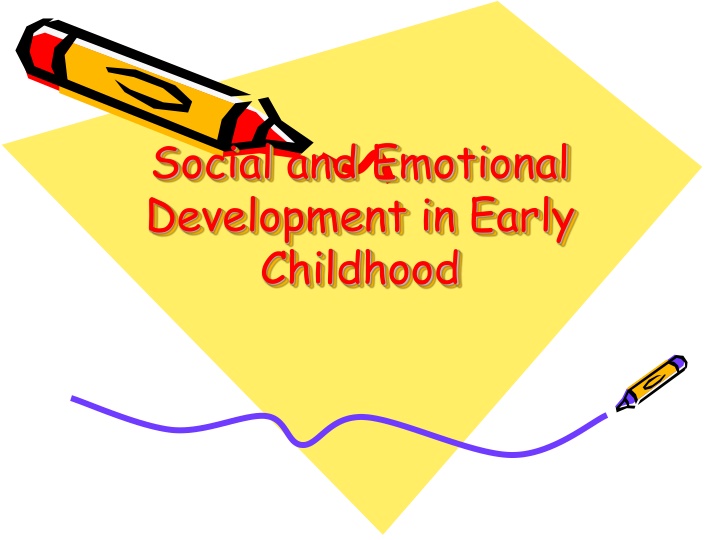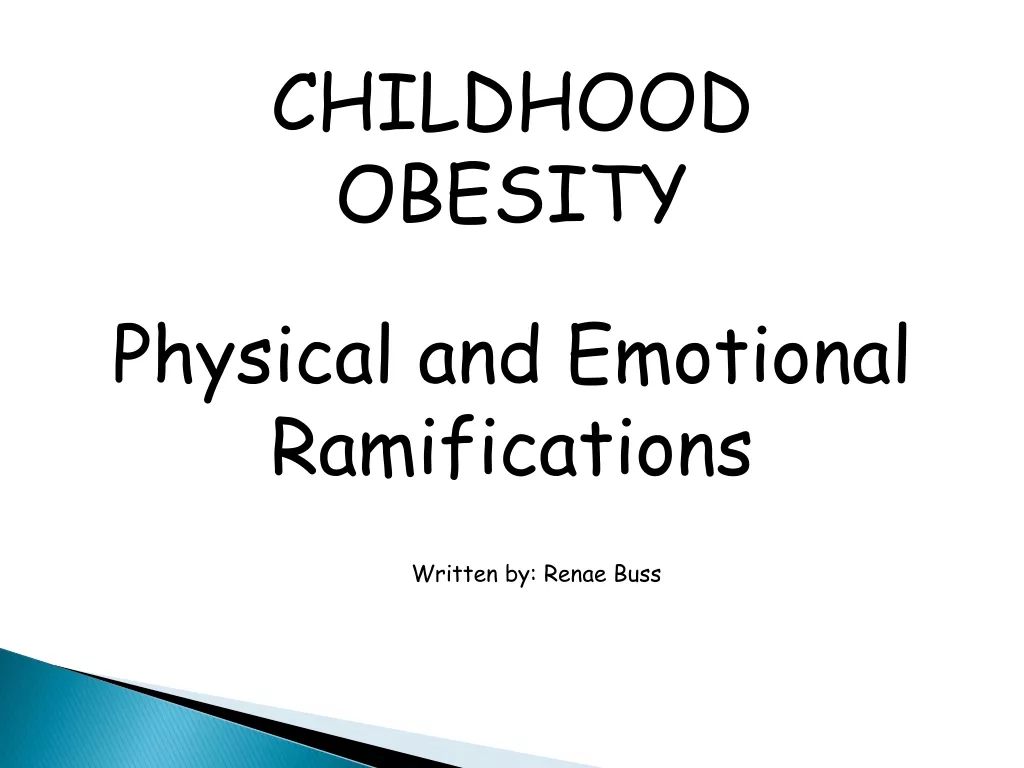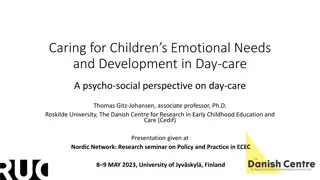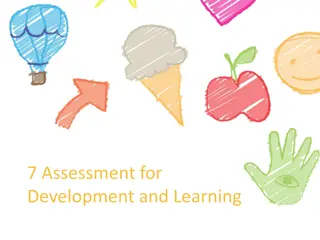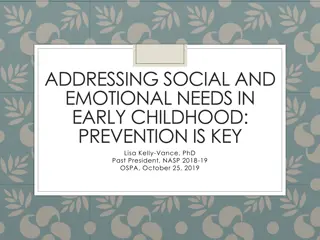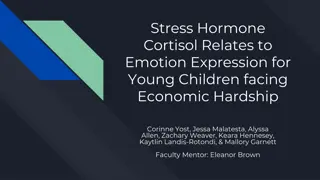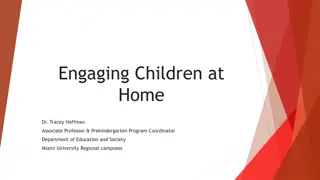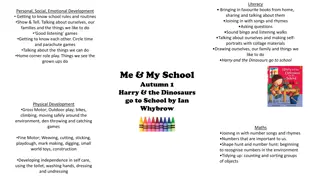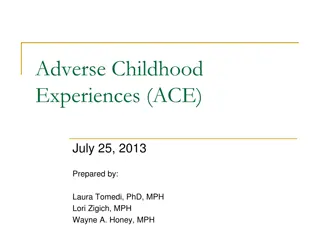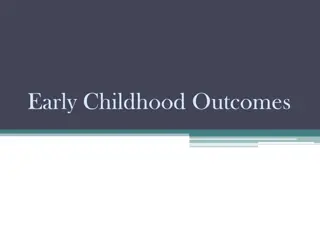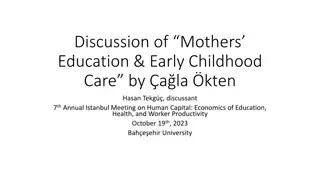Early Childhood Social and Emotional Development Insights
Social and emotional development in early childhood is influenced by various factors such as family dynamics, parenting styles, peer interactions, and cultural backgrounds. Erikson's stages highlight the importance of initiatives and self-understanding in shaping emotional growth. Parents play a crucial role in emotion-coaching or dismissing behaviors, impacting their children's self-awareness. Understanding the nuances of emotional development and self-perception is vital for fostering healthy growth in young children.
Download Presentation

Please find below an Image/Link to download the presentation.
The content on the website is provided AS IS for your information and personal use only. It may not be sold, licensed, or shared on other websites without obtaining consent from the author.If you encounter any issues during the download, it is possible that the publisher has removed the file from their server.
You are allowed to download the files provided on this website for personal or commercial use, subject to the condition that they are used lawfully. All files are the property of their respective owners.
The content on the website is provided AS IS for your information and personal use only. It may not be sold, licensed, or shared on other websites without obtaining consent from the author.
E N D
Presentation Transcript
Social and Emotional Development in Early Childhood
Social and Emotional Development Occurs in Contexts Family Parenting Play Peer relations Culture Influenced by temperament and other child characteristics
Erikson Shame and Doubt Initiative can bring guilt as well as rewards Too much guilt can be a problem Responses can create a sense of shame and self-doubt Harshly punitive Overly critical Rejecting Primarily parents but others as well Initiative Children use their developing skills to make things happen Motor Cognitive Language New sense of purpose Explore an expanding social world Governed by developing conscience Superego
Emotional development Awareness of self is linked to the ability to feel an expanding range of emotions Still confused by mixed emotions and some complex emotions Increase in the experience of self conscious emotions such as guilt and pride Important changes in emotional development: increased ability to talk about one s own and others emotions increase the number of terms they use to describe emotions
Emotion-Coaching and Emotion-Dismissing Parents Emotion-coaching parents monitor their children s emotions, view their children s negative emotions as opportunities for teaching, assist them in labeling emotions, and coach them in how to deal effectively with emotions Emotion-dismissing parents view their role as to deny, ignore, or change negative emotions Important in the development of self understanding, empathy, and morality (Katz, 1999)
Self-Understanding Self-understanding -- representation of self -- the substance and content of self-conceptions Early self-understanding involves self- recognition Young children describe the self with many material characteristics, such as size, shape, and color About 4 to 5 years of age, they begin to include psychological traits and emotion terms in their own self-descriptions (Harter, 2006) (Keller, Ford, & Meacham, 1978) (Marsh, Ellis, & Craven, 2002; Thompson, 2006)
Emotion and Peer Relationships Emotions regulation and understanding plays a strong role in determining the success of a child s peer relationships, esp. emotion regulation moody and emotionally negative children experience rejection by their peers positive children are more popular Some young children are better than others at understanding what people are feeling and what they desire Young children s theory of mind includes understanding that other people have emotions and desires About 4 to 5 years, they begin to perceive others in terms of psychological traits
Types of Play -Social Nonsocial Activity Solitary Play Onlooker behavior Plays near other children with similar materials, but does not try to influence them Declines across early childhood Associative Play separate activities but exchange toys and comment on each other s activities Cooperative play More advanced interaction in which children work together toward common goals, such as acting out a pretend scenario Parallel Play Social Interaction
Types of Play- Cognitive Category Functional Play (Sensorimotor and practice play) Description Simple repetitive movements done for pleasure (senorimotor play) or skill development (practice play Creating or constructing something Examples Jumping, running, moving, a car back and forth, Constructive Play Building a block building, drawing, puzzles Playing school, house, story or TV characters, cops and robbers, etc. Pretend Play Acting out observed or imaginary roles Appears by 2 and increases throughout early childhood
Early Friendships Based on proximity and playing together Someone who plays with you is your friend Friendships change frequently but do provide social support and opportunities to practice and learn social skills
Gender Gender -- social and psychological dimensions of being male or female Gender identity -- sense of being male or female Gender roles -- sets of expectations that prescribe how females or males should think, act, and feel preschool children act in ways that match their culture's gender roles and exhibit a sense of gender identity
Gender Gender identity and gender roles strengthen over the preschool years Boys engage in more active and rough and tumble play Girls most often initiate separating out from the boys Peers extensively reward and punish gender behavior peers often reject children who act in a manner that is characteristic of the other gender Gender based on roles, activities, and appearance Can be quite rigid even if parents model less rigid roles
Social Theories of Gender Development Social role theory -- contrasting roles of women and men Psychoanalytic theory of gender -- Freud s view -- preschool child develops a sexual attraction to the opposite-sex parent Oedipus (for boys) or Electra (for girls) complex Social cognitive theory of gender -- by observing and imitating and through being rewarded and punished (Alice Eagly, 2001) (Bussey & Bandura,
Gender Schemas and Behavior
Parental Influence on Gender Development By action and by example, parents influence their children s gender development cultures around the world give mothers and fathers different roles Mothers Socialization Strategies -- mothers socialize their daughters to be more obedient and responsible Fathers Socialization Strategies -- fathers show more attention to sons than daughters, engage in more activities with sons, and put forth more effort to promote sons intellectual development Parents enforce gender roles, esp. with sons (Grusec & Davidov, 2007)
Moral Development, Social Skills, Aggression and Parenting
Parental Influences on Early Peer Relations Direct Arrange informal peer activities Guidance on how to act toward others Indirect Secure attachment Emotionally expressive, sensitive communication Cooperative play
Characteristics of Good Models of Moral Behavior Warmth and responsiveness Competence and power Consistency between words and behavior
Characteristics of Child-Rearing Styles Acceptance Involvement Control Autonomy Authoritative High High Adaptive Appropriate Authoritarian Low Low High Low Too low or too high Permissive High Low High Uninvolved Low Low Low Indifference
Effective Parenting Prevent Misbehavior Set clear guidelines and expectations Set consistent routines Minimize demands when children are stressed, tired, hungry, etc. Develop a warm relationship Coach, model and reward appropriate behavior Inductive discipline helping a child to understand the effects of their misbehavior on others and correct the harm they have caused Associated with positive moral development Punish mildly, consistently, and sparingly Effectiveness declines and negative effects increase with harshness and inconsistency and greater frequency Use reasoning and explanations
Cultural, Ethnic, and Socioeconomic Variations in Parenting Authoritarian parenting is widespread in some cultures, including Chinese and Arab. Most parents in the world are controlling, but warm. Families are getting smaller in many countries. Large and extended families are more common among minority groups than among Whites. Single-parent families more common among Blacks and Latinos than among Whites. Asian parents tend to train child. Latino parents tend to encourage family identity and self-development. African American parents tend to use physical punishment more than Whites.
(c) 2008 The McGraw-Hill Companies, Inc.
Effects of Work on Parenting The nature of parents work rather than whether one parent works outside the home is significant parents who have poor working conditions are likely to be more irritable at home and engage in less effective parenting because household operations have become more efficient and family size has decreased, it is not certain that American children today receive less attention when both parents work (Crouter & McHale, 2005)(Clarke-Stewart, 2006) (Crouter, 2006)
Types of Child Maltreatment Physical abuse the infliction of physical injury Child neglect failure to provide for the child s basic needs Sexual abuse fondling a child s genitals, intercourse, incest, rape, sodomy, etc. Emotional abuse psychological/verbal abuse/mental injury acts/omissions that have caused, or could cause, serious behavioral, cognitive, or emotional problems
Consequences of Abuse Poor emotion regulation, attachment problems, problems in peer relations, difficulty in adapting to school, and other psychological problems such as depression and delinquency Difficulty in establishing and maintaining healthy intimate relationships As adults, they are at higher risk for violent behavior toward other adults, as well as for substance abuse, anxiety, and depression (Cicchetti & Toth, 2005, 2006) (Minzenberg, Poole, & Vinogradov, 2006) (Shea & others, 2005)
Prevention of Maltreatment In a recent study, two treatments were effective in reducing child maltreatment: home visitation that emphasized improved parenting, coping with stress, and increasing support for the mother parent-infant psychotherapy that focused on improving maternal-infant attachment (Cicchetti, Toth, and Rogosch, 2005) Reduce parent stress
Consequences of Divorce Children in divorced families are more likely to have academic problems show externalized problems (such as acting out and delinquency) and internalized problems (such as anxiety and depression) have less competent intimate relationships drop out of school become sexually active at an early age take drugs have low self-esteem A majority of children in divorced families do not have significant adjustment problems (Hetherington, 2005, 2006; Huurre, Junkkari, & Aro, 2006) (Conger & Chao, 1996) (Barber & Demo, 2006)
Divorce Adjustment When divorced parents relationship with each other is harmonious and when they use authoritative parenting, the adjustment of children improves Children who are socially mature and responsible, who show few behavioral problems, and who have an easy temperament are better able to cope Children with a difficult temperament often have problems in coping with their parents divorce (Clarke-Stewart & Brentano, 2006; Walper Beckh, 2006) (Hetherington, 2005, 2006) (Hetherington, 2000)
Socioeconomic Issues of Divorce Custodial mothers experience the loss of about one-fourth to one-half of their pre-divorce income This income loss for divorced mothers is accompanied by increased workloads, high rates of job instability, and residential moves to less desirable neighborhoods with inferior schools Custodial fathers have a loss of only one-tenth of their pre-divorce income (Sayer, 2006) (Emery, 1994)
Guidelines for Communicating with Children about Divorce Explain the separation Explain that the separation is not the child s fault Explain that it may take time to feel better Keep the door open for further discussion Provide as much continuity as possible (Galinsky & David,1988)
